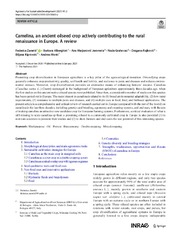Приказ основних података о документу
Camelina, an ancient oilseed crop actively contributing to the rural renaissance in Europe. A review
| dc.creator | Zanetti, Federica | |
| dc.creator | Alberghini, Barbara | |
| dc.creator | Marjanović-Jeromela, Ana | |
| dc.creator | Grahovac, Nada | |
| dc.creator | Rajković, Dragana | |
| dc.creator | Kiprovski, Biljana | |
| dc.creator | Monti, Andrea | |
| dc.date.accessioned | 2021-04-26T19:58:45Z | |
| dc.date.available | 2021-04-26T19:58:45Z | |
| dc.date.issued | 2021 | |
| dc.identifier.issn | 1774-0746 | |
| dc.identifier.uri | http://fiver.ifvcns.rs/handle/123456789/2092 | |
| dc.description.abstract | Promoting crop diversification in European agriculture is a key pillar of the agroecological transition. Diversifying crops generally enhances crop productivity, quality, soil health and fertility, and resilience to pests and diseases and reduces environmental stresses. Moreover, crop diversification provides an alternative means of enhancing farmers' income. Camelina (Camelina sativa (L.) Crantz) reemerged in the background of European agriculture approximately three decades ago, when the first studies on this ancient native oilseed species were published. Since then, a considerable number of studies on this species has been carried out in Europe. The main interest in camelina is related to its (1) broad environmental adaptability, (2) low-input requirements, (3) resistance to multiple pests and diseases, and (4) multiple uses in food, feed, and biobased applications. The present article is a comprehensive and critical review of research carried out in Europe (compared with the rest of the world) on camelina in the last three decades, including genetics and breeding, agronomy and cropping systems, and end-uses, with the aim of making camelina an attractive new candidate crop for European farming systems. Furthermore, a critical evaluation of what is still missing to scale camelina up from a promising oilseed to a commonly cultivated crop in Europe is also provided (1) to motivate scientists to promote their studies and (2) to show farmers and end-users the real potential of this interesting species. | en |
| dc.publisher | Springer France, Paris | |
| dc.relation | Alma Mater Studiorum Universita di Bologna within the CRUI-CARE Agreement | |
| dc.relation | info:eu-repo/grantAgreement/EC/H2020/727698/EU// | |
| dc.relation | ARGENTO project - Italian Research Projects of Relevant National Interest - Announcement 2017 [2017LZ3CHF] | |
| dc.relation | info:eu-repo/grantAgreement/MESTD/inst-2020/200032/RS// | |
| dc.rights | openAccess | |
| dc.source | Agronomy for Sustainable Development | |
| dc.subject | Multipurpose | en |
| dc.subject | Oil | en |
| dc.subject | Protein | en |
| dc.subject | Bioeconomy | en |
| dc.subject | Double cropping | en |
| dc.subject | Mixed cropping | en |
| dc.title | Camelina, an ancient oilseed crop actively contributing to the rural renaissance in Europe. A review | en |
| dc.type | article | |
| dc.rights.license | ARR | |
| dc.citation.issue | 1 | |
| dc.citation.other | 41(1) | |
| dc.citation.rank | aM21 | |
| dc.citation.volume | 41 | |
| dc.identifier.doi | 10.1007/s13593-020-00663-y | |
| dc.identifier.fulltext | http://fiver.ifvcns.rs/bitstream/id/1021/2089.pdf | |
| dc.identifier.scopus | 2-s2.0-85098857396 | |
| dc.identifier.wos | 000605627000001 | |
| dc.type.version | publishedVersion |


